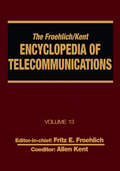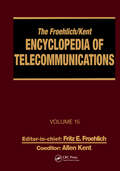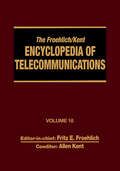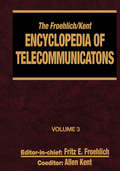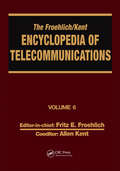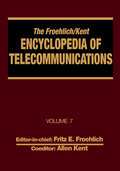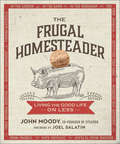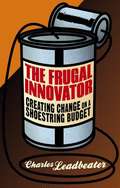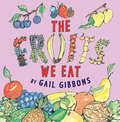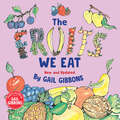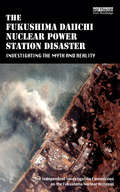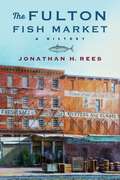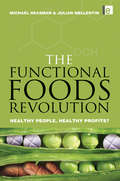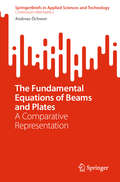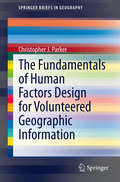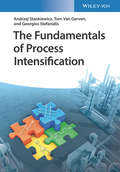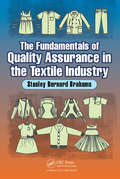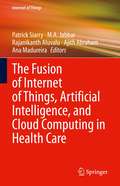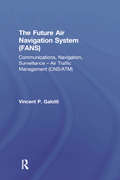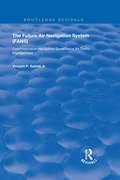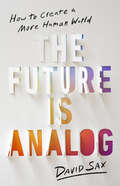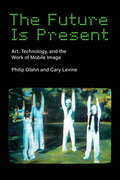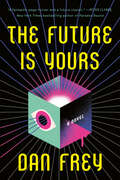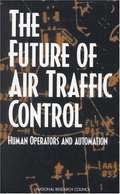- Table View
- List View
The Froehlich/Kent Encyclopedia of Telecommunications: Volume 13 - Network-Management Technologies to NYNEX
by Allen Kent Fritz E. FroehlichThis article reviews network-management problems, technologies and standards, outlining the problems and challenges of the field. It overviews the functions and architectures, of various components of network-management systems (NMSs), describing key network-management application areas.
The Froehlich/Kent Encyclopedia of Telecommunications: Volume 15 - Radio Astronomy to Submarine Cable Systems
by Allen Kent Fritz E. FroehlichThis is volume fifteen of the Encyclopedia of Telecommunications, which covers Radio Astronomy to Submarine Cable Systems in alphabetical listing and information on the contributors
The Froehlich/Kent Encyclopedia of Telecommunications: Volume 18 - Wireless Multiple Access Adaptive Communications Technique to Zworykin: Vladimir Kosma
by Allen Kent Fritz E. FroehlichVolume 18- Wireless Multiple Access Adaptive Communications Technique to Zworykin, Vladimir Kosma. The only continuing source that helps users analyze, plan, design, evaluate, and manage integrated telecommunications networks, systems, and services, The Froehlich/Kent Encyclopedia of Telecommunications presents both basic and technologically advanced knowledge in the field. An ideal reference source for both newcomers as well as seasoned specialists, the Encyclopedia covers seven key areas--Terminals and Interfaces; Transmission; Switching, Routing, and Flow Control; Networks and Network Control; Communications Software and Protocols; Network and system Management; and Components and Processes.
The Froehlich/Kent Encyclopedia of Telecommunications: Volume 3 - Codes for the Prevention of Errors to Communications Frequency Standards
by Allen Kent Fritz E. Froehlich"The only continuing source that helps users analyze, plan, design, evaluate, and manage integrated telecommunications networks, systems, and services, The Froehlich/Kent Encyclopedia of Telecommunications presents both basic and technologically advanced knowledge in the field. An ideal reference source for both newcomers as well as seasoned specialists, the Encyclopedia covers seven key areas--Terminals and Interfaces; Transmission; Switching, Routing, and Flow Control; Networks and Network Control; Communications Software and Protocols; Network and system Management; and Components and Processes."
The Froehlich/Kent Encyclopedia of Telecommunications: Volume 6 - Digital Microwave Link Design to Electrical Filters
by Allen Kent Fritz E. Froehlich"The only continuing source that helps users analyze, plan, design, evaluate, and manage integrated telecommunications networks, systems, and services, The Froehlich/Kent Encyclopedia of Telecommunications presents both basic and technologically advanced knowledge in the field. An ideal reference source for both newcomers as well as seasoned specialists, the Encyclopedia covers seven key areas--Terminals and Interfaces; Transmission; Switching, Routing, and Flow Control; Networks and Network Control; Communications Software and Protocols; Network and system Management; and Components and Processes."
The Froehlich/Kent Encyclopedia of Telecommunications: Volume 7 - Electrical Filters: Fundamentals and System Applications to Federal Communications Commission of the United States
by Allen Kent Fritz E. Froehlich"The only continuing source that helps users analyze, plan, design, evaluate, and manage integrated telecommunications networks, systems, and services, The Froehlich/Kent Encyclopedia of Telecommunications presents both basic and technologically advanced knowledge in the field. An ideal reference source for both newcomers as well as seasoned specialists, the Encyclopedia covers seven key areas--Terminals and Interfaces; Transmission; Switching, Routing, and Flow Control; Networks and Network Control; Communications Software and Protocols; Network and system Management; and Components and Processes."
The Frugal Homesteader: Living the Good Life on Less
by John Moody&“Practical advice . . . from the farm field to foraging in the forest . . . a must-have for anyone looking to transition from homeowner to homesteader.&”—Scott Mann, host of The Permaculture Podcast Build your homesteading dreams with all the affordable DIY innovations, tips, and stories you need to successfully launch you on a path to self-sufficiency. Raise and grow your own food, connect with nature, and consume less while producing more!The Frugal Homesteader is a fun, inspirational, and educational guide filled with a lifetime of learning that comes along with becoming a homesteader. Following dozens of successful families who have been motivated to make do, make new, and make more while saving money and living off the land, this book covers such topics as:Outfitting your garden Equipping your barn and outbuildings Protecting and providing for your animals Harvesting rainwater Heating with wood Foraging Producing more of what you need to thrive in harder times. Whether you&’re just starting out and looking for new, sustainable, and affordable ideas, approaches, and techniques, or you&’re a small-scale farmer in regenerative agriculture, The Frugal Homesteader is the DIY manual to help you succeed. &“This book is worth its weight in gold . . . an account of direct lived experience: jam-packed with tips and tricks from doing the homestead life each and every day.&”—Ben Falk, homesteader and author of The Resilient Farm and Homestead &“This is a rich bounty of ideas that will be equally usefully to old hands and shiny new start-ups alike, whether on rural acreage or urban lot.&”—Jenni Blackmore, author of The Food Lover&’s Garden
The Frugal Innovator
by Charles LeadbeaterThis insightful book looks at the phenomenon of low-cost innovation and explores what we can learn from the innovators in developing nations who are making amazing technical and social advances with scarce capital and resources. Charles Leadbeater shows how these methods can be applied and used wherever you are and whatever your capital.
The Fruits We Eat
by Gail GibbonsBerries, apples, melons, and grapes; oranges, grapefruits, bananas -- yum! This scrumptious picture book, a companion to The Vegetables We Eat, offers youngsters an inviting, information-packed cornucopia of favorite fruits. Gail Gibbons combines a clear, simple text with her signature illustrations to present fruit facts galore: the parts of fruits, where and how they grow, harvesting, processing, where to buy them, and how to enjoy them as part of a healthy diet.
The Fruits We Eat (New & Updated)
by Gail GibbonsFrom #1 science writer for kids Gail Gibbons, learn everything about the delicious fruits you eat with this new and updated edition.Berries, apples, melons, and grapes; oranges, grapefruits, bananas -- yum! This scrumptious, updated picture book, a companion to The Vegetables We Eat, offers youngsters an inviting, information-packed cornucopia of favorite fruits.Gail Gibbons combines a clear, simple text with her signature illustrations to present fruit facts galore: the parts of fruits, where and how they grow, harvesting, processing, where to buy them, and how to enjoy them as part of a healthy diet.
The Fukushima Daiichi Nuclear Power Station Disaster: Investigating the Myth and Reality
by The Fukushima Nuclear AccidentWhen the Nuclear Safety Commission in Japan reviewed safety-design guidelines for nuclear plants in 1990, the regulatory agency explicitly ruled out the need to consider prolonged AC power loss. In other words, nothing like the catastrophe at the Fukushima Daiichi Nuclear Power Station was possible—no tsunami of 45 feet could swamp a nuclear power station and knock out its emergency systems. No blackout could last for days. No triple meltdown could occur. Nothing like this could ever happen. Until it did—over the course of a week in March 2011. In this volume and in gripping detail, the Independent Investigation Commission on the Fukushima Nuclear Accident, a civilian-led group, presents a thorough and powerful account of what happened within hours and days after this nuclear disaster, the second worst in history. It documents the findings of a working group of more than thirty people, including natural scientists and engineers, social scientists and researchers, business people, lawyers, and journalists, who researched this crisis involving multiple simultaneous dangers. They conducted over 300 investigative interviews to collect testimony from relevant individuals. The responsibility of this committee was to act as an external ombudsman, summarizing its conclusions in the form of an original report, published in Japanese in February 2012. This has now been substantially rewritten and revised for this English-language edition. The work reveals the truth behind the tragic saga of the multiple catastrophic accidents at the Fukushima Daiichi Nuclear Power Station.It serves as a valuable and essential historical reference, which will help to inform and guide future nuclear safety and policy in both Japan and internationally.
The Fulton Fish Market: A History (Arts and Traditions of the Table: Perspectives on Culinary History)
by Jonathan H. ReesThe Fulton Fish Market stands out as an iconic New York institution. At first a neighborhood retail market for many different kinds of food, it became the nation’s largest fish and seafood wholesaling center by the late nineteenth century. Waves of immigrants worked at the Fulton Fish Market and then introduced the rest of the city to their seafood traditions. In popular culture, the market—celebrated by Joseph Mitchell in The New Yorker—conjures up images of the bustling East River waterfront, late-night fishmongering, organized crime, and a vanished working-class New York.This book is a lively and comprehensive history of the Fulton Fish Market, from its founding in 1822 through its move to the Bronx in 2005. Jonathan H. Rees explores the market’s workings and significance, tracing the transportation, retailing, and consumption of fish. He tells the stories of the people and institutions that depended on the Fulton Fish Market—including fishermen, retail stores, restaurants, and chefs—and shows how the market affected what customers in New York and around the country ate. Rees examines transformations in food provisioning systems through the lens of a vital distribution point, arguing that the market’s wholesale dealers were innovative businessmen who adapted to technological change in a dynamic industry. He also explains how changes in the urban landscape and economy affected the history of the market and the surrounding neighborhood.Bringing together economic, technological, urban, culinary, and environmental history, this book demonstrates how the Fulton Fish Market shaped American cuisine, commerce, and culture.
The Functional Foods Revolution: "Healthy People, Healthy Profits"
by Michael Heasman Julian MellentinFoods that promote human health - 'functional foods' or nutraceuticals - have caught the imagination of the global food industry. All the household-name companies are developing them as a key driver in their global strategies. They see the prospect of new markets and bigger margins, but the issues presented are fraught with complexity and difficulties. Distinguishing hype from real hope, the authors of this handbook explain the dilemmas and contradictions the industry faces. They present a wealth of detailed marketing, food policy and regulatory material from the leading markets world-wide and show how the hopes of the industry, and the consumer, may be dashed. The solution they offer is radical - nothing less than a new business model of what they term a healthful company.
The Fundamental Equations of Beams and Plates: A Comparative Representation (SpringerBriefs in Applied Sciences and Technology)
by Andreas ÖchsnerThis book focuses on beam and plate elements, essential components found across various fields from automotive and aerospace engineering to civil engineering structures. It offers a comparative exploration of the fundamental equations governing thin and thick beams, as well as thin and thick plates, providing readers with a clear understanding of these foundational structural elements. By explaining the three fundamental equations of continuum mechanics—equilibrium, kinematics, and constitution—the text culminates in a unified differential equation framework, offering both beginners and experienced practitioners a fresh perspective on structural member modeling.
The Fundamentals of Human Factors Design for Volunteered Geographic Information
by Christopher J. ParkerThis book explores the roles in which volunteered and professional information play within neogeography from a human factors perspective. The unique advantages of each information type are considered alongside how they may be utilised to create products and services delivering highly functional, efficient and satisfying experiences to their users. The overall aim of this book is to address the issue of how Volunteered Geographic Information (VGI) can be combined with Professional Geographic Information (PGI) to satisfy the information search requirements of consumer-users via highly usable mashups. Firstly, this required the development of an understanding of the way different users perceive VGI and PGI in terms of its benefits to their activities and information needs. Secondly, the benefits that VGI may bring to the user experience of a mashup (which cannot be attained through the use of PGI) needed to be understood. In order to achieve this, a user centred design perspective was implemented throughout the research.
The Fundamentals of Process Intensification
by Andrzej Stankiewicz Tom Van Gerven Georgios StefanidisThis advanced textbook covering the fundamentals and industry applications of process intensification (PI) discusses both the theoretical and conceptual basis of the discipline. Since interdisciplinarity is a key feature of PI, the material contained in the book reaches far beyond the classical area of chemical engineering. Developments in other relevant disciplines, such as chemistry, catalysis, energy technology, applied physics, electronics and materials science, are extensively described and discussed, while maintaining a chemical engineering perspective. Divided into three major parts, the first introduces the PI principles in detail and illustrates them using practical examples. The second part is entirely devoted to fundamental approaches of PI in four domains: spatial, thermodynamic, functional and temporal. The third and final part explores the methodology for applying fundamental PI approaches in practice. As well as detailing technologies, the book focuses on safety, energy and environmental issues, giving guidance on how to incorporate PI in plant design and operation -- safely, efficiently and effectively.
The Fundamentals of Quality Assurance in the Textile Industry
by Stanley Bernard BrahamsThe role of quality assurance is to ensure that once a specification has been agreed, every product and every production run meets that standard. The Fundamentals of Quality Assurance in the Textile Industry describes how quality professionals in the apparel industry coordinating with overseas factories can ensure excellence. The author explains what tools are required and how to manage products from style conception to finished production and the methods used to track and evaluate samples and production at each stage of the critical path. This book reinforces the concept that quality assurance must become an integral part of the business and details crucial procedures that have been adopted internationally.
The Fusion of Internet of Things, Artificial Intelligence, and Cloud Computing in Health Care (Internet of Things)
by Ajith Abraham Patrick Siarry Ana Madureira M. A. Jabbar Rajanikanth AluvaluThis book reviews the convergence technologies like cloud computing, artificial intelligence (AI) and Internet of Things (IoT) in healthcare and how they can help all stakeholders in the healthcare sector. The book is a proficient guide on the relationship between AI, IoT and healthcare and gives examples into how IoT is changing all aspects of the healthcare industry. Topics include remote patient monitoring, the telemedicine ecosystem, pattern imaging analytics using AI, disease identification and diagnosis using AI, robotic surgery, prediction of epidemic outbreaks, and more. The contributors include applications and case studies across all areas of computational intelligence in healthcare data. The authors also include workflow in IoT-enabled healthcare technologies and explore privacy and security issues in healthcare-based IoT.
The Future Air Navigation System: Communications, Navigation, Surveillance – Air Traffic Management (CNS/ATM) (Routledge Revivals Ser.)
by Vincent P. GalottiIn view of the increase in air traffic, there has been a great deal of work by the nations of the world, under the auspices of ICAO, toward developing the concept for a future air navigation infrastructure to serve worldwide civil aviation efficiency. Even though the concept is well described and implementation is beginning, only technical manuals are available to advance the systems concept. This book describes the global vision for the Future Air Navigation System (FANS) and is the first text of its kind dedicated solely to Communications Navigation, Surveillance/Air Traffic Management and the CNS/ATM systems concept. In addition to the technical issues associated with CNS/ATM, the book also examines institutional, economic, labour and Human Factors issues. It is designed as a text usable in the classroom environment in universities and aviation technical schools.
The Future Air Navigation System: Communications, Navigation, Surveillance – Air Traffic Management (CNS/ATM) (Routledge Revivals)
by Vincent P. GalottiFirst published in 1997, this volume responds to the increase in air traffic, as there has been a great deal of work by the nations of the world, under the auspices of ICAO, toward developing the concept for a future air navigation infrastructure to serve worldwide civil aviation efficiency. Even though the concept is well described and implementation is beginning, only technical manuals are available to advance the systems concept. This book describes the global vision for the Future Air Navigation System (FANS) and is the first text of its kind dedicated solely to Communications Navigation, Surveillance/Air Traffic Management and the CNS/ATM systems concept. In addition to the technical issues associated with CNS/ATM, the book also examines institutional, economic, labour and Human Factors issues. It is designed as a text usable in the classroom environment in universities and aviation technical schools.
The Future European Energy System: Renewable Energy, Flexibility Options and Technological Progress
by Dominik Möst Steffi Schreiber Andrea Herbst Martin Jakob Angelo Martino Witold-Roger PoganietzThis open access book analyzes the transition toward a low-carbon energy system in Europe under the aspects of flexibility and technological progress. By covering the main energy sectors – including the industry, residential, tertiary and transport sector as well as the heating and electricity sector – the analysis assesses flexibility requirements in a cross-sectoral energy system with high shares of renewable energies. The contributing authors – all European energy experts – apply models and tools from various research fields, including techno-economic learning, fundamental energy system modeling, and environmental and social life cycle as well as health impact assessment, to develop an innovative and comprehensive energy models system (EMS). Moreover, the contributions examine renewable penetrations and their contributions to climate change mitigation, and the impacts of available technologies on the energy system. Given its scope, the book appeals to researchers studying energy systems and markets, professionals and policymakers of the energy industry and readers interested in the transformation to a low-carbon energy system in Europe.
The Future Is Analog: How to Create a More Human World
by David SaxBestselling culture writer David Sax lays out the case against a false digital utopia—and for a more human future In The Future Is Analog, David Sax points out that the onset of the pandemic instantly gave us the digital universe we&’d spent so long anticipating. Instant communication, online shopping, virtual everything. It didn&’t take long to realize how awful it was to live in this promised future. We craved real experiences, relationships, and spaces and got back to real life as quickly and often as we could. In chapters exploring work, school, religion, and more, this book asks pointed questions: Is our future inevitably digital? Can we reject the downsides of digital technology without rejecting change? Can we innovate not for the sake of productivity but for the good of our social and cultural lives? Can we build a future that serves us as humans, first and foremost? This is a manifesto for a different kind of change. We can spend our creativity and money on building new gadgets—or we can spend them on new ways to be together and experience the world, to bake bread, and climb mountains. All we need is the clarity to choose which future we want.
The Future Is Present: Art, Technology, and the Work of Mobile Image (Leonardo)
by Cary Levine Philip GlahnA critical history of the pioneering art and technology group Mobile Image and their prescient work in communications, networking, and information systems.In The Future Is Present, Philip Glahn and Cary Levine tell the fascinating history of the visionary art group Mobile Image—founded by Kit Galloway and Sherrie Rabinowitz in 1977—which appropriated emerging technologies, from satellites to electronic message platforms. Based in Los Angeles, this under-studied collective worked amid urban crisis, a techno-boom, consolidating media power, and ascendant neoliberal politics. Mobile Image challenged fundamental conventions of the public sphere, democracy, communication, and political participation, as well as notions of power, representation, and identity.Glahn and Levine argue not only for the historical importance of Mobile Image, but also for a critical artistic process that is at once analytic and transformative. They weave themes such as embodiment and its mediation, public/private dialectics, and techno-utopian vision throughout the book, binding these projects to discourses around race, gender, and class, as well as margin and center, the local and the global. In today&’s world of ubiquitous digital re/production, networking, and social media, The Future Is Present shows how the work of Mobile Image continues to have profound implications for art, technology, and the politics of public and private experience.
The Future Is Yours: A Novel
by Dan FreyTwo best friends create a computer that can predict the future. But what they can&’t predict is how it will tear their friendship—and society—apart.&“An impossibly addictive brainteaser wrapped in a buttery popcorn kernel.&”—Aneesh Chaganty, director and co-writer of Searching and RunIN DEVELOPMENT AS AN HBO MAX ORIGINAL SERIESIf you had the chance to look one year into the future, would you? For Ben Boyce and Adhi Chaudry, the answer is unequivocally yes. And they&’re betting everything that you&’ll say yes, too. Welcome to The Future: a computer that connects to the internet one year from now, so you can see who you&’ll be dating, where you&’ll be working, even whether or not you&’ll be alive in the year to come. By forming a startup to deliver this revolutionary technology to the world, Ben and Adhi have made their wildest, most impossible dream a reality. Once Silicon Valley outsiders, they&’re now its hottest commodity. The device can predict everything perfectly—from stock market spikes and sports scores to political scandals and corporate takeovers—allowing them to chase down success and fame while staying one step ahead of the competition. But the future their device foretells is not the bright one they imagined.Ambition. Greed. Jealousy. And, perhaps, an apocalypse. The question is . . . can they stop it?Told through emails, texts, transcripts, and blog posts, this bleeding-edge tech thriller chronicles the costs of innovation and asks how far you&’d go to protect the ones you love—even from themselves.
The Future Of Air Traffic Control: Human Operators And Automation
by Panel on Human Factors in Air Traffic Control AutomationAutomation in air traffic control may increase efficiency, but it also raises questions about adequate human control over automated systems. Following on the panel's first volume on air traffic control automation, Flight to the Future (NRC, 1997), this book focuses on the interaction of pilots and air traffic controllers, with a growing network of automated functions in the airspace system.The panel offers recommendations for development of human-centered automation, addressing key areas such as providing levels of automation that are appropriate to levels of risk, examining procedures for recovery from emergencies, free flight versus ground-based authority, and more.The book explores ways in which technology can build on human strengths and compensate for human vulnerabilities, minimizing both mistrust of automation and complacency about its abilities. The panel presents an overview of emerging technologies and trends toward automation within the national airspace system--in areas such as global positioning and other aspects of surveillance, flight information provided to pilots an controllers, collision avoidance, strategic long-term planning, and systems for training and maintenance.The book examines how to achieve better integration of research and development, including the importance of user involvement in air traffic control. It also discusses how to harmonize the wide range of functions in the national airspace system, with a detailed review of the free flight initiative.
